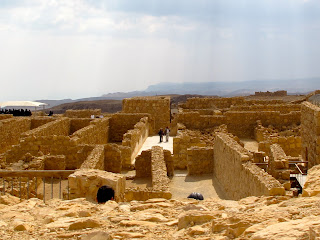
 We awoke early and hopped on the purple bus where we headed further south to Masada. Perched high atop a mountain overlooking the Dead Sea is the fortress commissioned by King Herod as a winter palace. Herod never set foot in Masada however. You can see from the bronze replica why this location made a wonderful fortress. Herod had enough food for a 5 year siege to hold 1,000 men. A narrow snake trail led to the top of the palace, wide enough for only one person at a time to travel. You can read more about this in Deut. 6.
We awoke early and hopped on the purple bus where we headed further south to Masada. Perched high atop a mountain overlooking the Dead Sea is the fortress commissioned by King Herod as a winter palace. Herod never set foot in Masada however. You can see from the bronze replica why this location made a wonderful fortress. Herod had enough food for a 5 year siege to hold 1,000 men. A narrow snake trail led to the top of the palace, wide enough for only one person at a time to travel. You can read more about this in Deut. 6.After Jerusalem's fall in 70 A.D., Masada represented the last Jewish resistance to the powerful Roman Empire. In order to penetrate the fortress, the governor of Rome, Flavius Silva, constructed a huge ramp. When the Romans made it to the top, they saw how determined the Jews were not to be conquered again. They found all but seven of the Jews had been killed or committed suicide. The actual lots that were used to determine how and when these deaths would happen were discover.
Because there were a few remaining children and women, the truth about the final days has been recorded.


Masada has been destroyed by earthquakes over time. Archaeologists have marked a black line around the stone walls where they have added or rebuilt walls. Remember our guide Ido? Well, as a captain in the Navy, he and his men climbed the snake trail and upon reaching the top their commanding officer gave each of them a bible and a rifle. They all repeated "Masada; This will never happen again." Masada is almost 1500 feet above the Dead Sea and 300 feet above sea level. You can see how it looks down over the land and sea below. It was an amazing place to view and probably one of my most favorite.
 We are at the lowest place on earth-1,300 feet below sea level to be exact. The water is beautiful, calm and loaded with salt; 33% to be exact. The minerals and black mud from the sea are supposed to be the best thing for your skin, so we coated up and then went into the salty water to scrub it off. I thought it was just about one of the most disgusting things I have ever done!
We are at the lowest place on earth-1,300 feet below sea level to be exact. The water is beautiful, calm and loaded with salt; 33% to be exact. The minerals and black mud from the sea are supposed to be the best thing for your skin, so we coated up and then went into the salty water to scrub it off. I thought it was just about one of the most disgusting things I have ever done!








